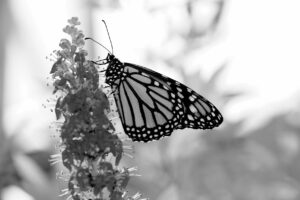
Monarch butterflies may appear fragile, but as a whole the species is extraordinarily hardy. Every year, the Eastern North American monarch butterfly population migrates thousands of miles from southern Ontario to overwinter in Mexico.
This impressive migration is multi-generational. After wintering in massive butterfly bunches, the monarchs wake and journey to areas in Texas and Oklahoma to breed and lay the eggs for the next generation.
Newly hatched monarchs instinctively know how, when and where to journey back north. This remarkable cycle of migration and regeneration that spans the continent is still not fully understood by entomologists.
This natural phenomenon is the protagonist in Barbara Kingsolver’s Flight Behavior (2012). In the novel, monarchs that have been migrating from Ontario to their breeding grounds in Mexico for thousands of years mistakenly roost in the Appalachian mountain range near a small farming town in Tennessee. Kingsolver explores the environmental, social and scientific impacts of climate change by tracking how seemingly isolated events, like a mudslide in Mexico and a surprisingly warm winter in Tennessee, can have devastating ripple effects on a whole species.
Flight Behavior is a suspenseful read: the survival of the entire generation of butterflies hangs in the balance of a few degrees Fahrenheit.
But while Kingsolver does an excellent job of capturing a distressing and prescient sign of the impacts of global warming, the real achievement of the book is the way it shows how environmental issues reverberate through the entire ecosystem, from the level of the individual to the community. Whether it is the personal struggle of Dellarobia (a young mother of two seeking to redefine herself within the context of a failing marriage), or the social and economic health of the small farming community, the mistaken arrival of the butterfly population and their struggle to survive affects everyone.
Kingsolver’s Flight Behavior is a story about the delicate dance of survival that plays out on independently-run farming communities, between a wife and her husband, and within monarch butterfly populations. It is a story about grief, hope, the crushing weight of poverty and the possibility of overturning self-imposed limitations. It is about a mother struggling to find her own identity again and a son opening his eyes to learning about the natural world.
Novels like Flight Behavior are excellent tools for making complex concepts like global climate change accessible to audiences who are not likely to tackle scientific literature. That it does so with sudden bursts of lyrical colour like the rising columns of monarchs in the millions makes for all the more engaging read. It is available at the Whitehorse Public Library and in the communities through the Yukon Public Library loan system.




